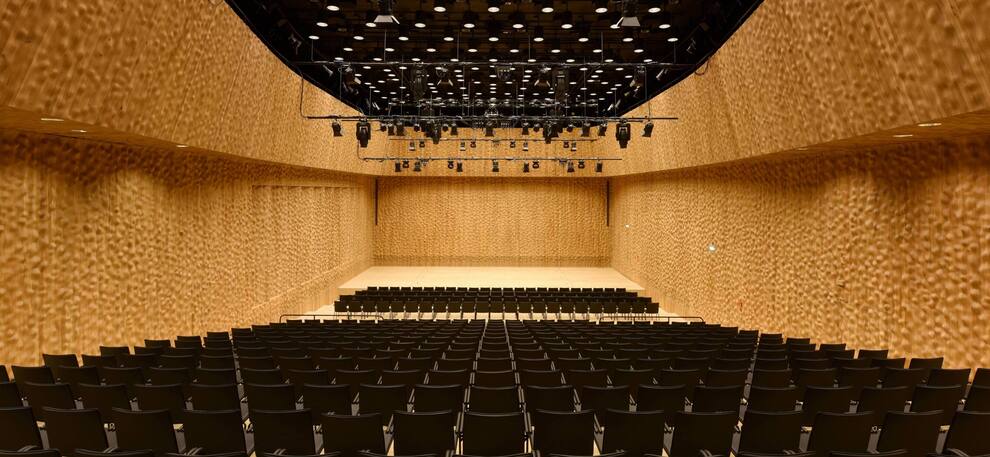Sun, Mar. 09, 2025, 11.00 am | Elbphilharmonie, Recital Hall
4th chamber concert
Giacomo Puccini: Tre minuetti for string quartet
Toshio Hosokawa: “Landscape II” for harp and string quartet
Claude Debussy: “Danse sacrée” and “Danse profane” for harp and strings
Ludwig van Beethoven: String Quartet No. 10 in E flat major op. 74 - “Harp Quartet”
Harp: Lena-Maria Buchberger
Kizuna-Quartett:
Violin: Mitsuru Shiogai
Violin: Sidsel Garm Nielsen
Viola: Minako Uno-Tollmann
Violoncello: Markus Tollmann
Lena-Maria Buchberger
HarpLena-Maria Buchberger was born in Frankfurt am Main and began playing the harp with Esther Groß at the age of eleven. She studied with Prof. Maria Graf at the Hanns Eisler Academy of Music and with Prof. Xavier de Maistre at the Hamburg University of Music and Drama.
From 2010 to 2012 she was a scholarship holder of the Karajan Academy of the Berliner Philharmoniker, where she was mentored by Marie-Pierre Langlamet.
As a solo harpist, she has performed with the Berliner Philharmoniker, the Tonhalle Orchestra Zurich and the WDR Symphony Orchestra, among others, and has gained experience under Claudio Abbado, Sir Simon Rattle, Zubin Mehta, Christian Thielemann and Bernard Haitink.
Concert tours have taken her to Asia, Australia, the USA and through large parts of Europe.
In the 2009/2010 season, she performed in the "Bundesauswahl Konzerte Junger Künstler" of the German Music Council, and in 2014 she was awarded the Ritter Prize of the Oscar and Vera Ritter Foundation.
Lena-Maria Buchberger has been principal harpist of the Hamburg Philharmonic State Orchestra since 2013.
Sidsel Garm Nielsen
ViolinSidsel Garm Nielsen was born in Thisted, Denmark, in 1973. She studied in Lübeck and Freiburg with Nora Chastain and Rainer Kussmaul. Even during her student days, she was third concertmaster of the Lübeck Philharmonic Orchestra (1996-1997), followed by a limited contract with the Staatskapelle Dresden (2001-2002). Since 1999 she has been a member of the Linos Ensemble; since 2002 she has been a member of the first violin section of the Hamburg Philharmonic State Orchestra.
Minako Uno-Tollmann
ViolaMinako Uno-Tollmann began studying at the Tokyo Music Academy in 1989 and continued her studies with Hirofumi Fukai at the Hamburg Music Academy in 1993. She did post-graduate work with Jürgen Kussmaul in Düsseldorf, which she completed with a performance degree in 2001. She participated in master courses with Wolfram Christ, Gérard Caussé and the Amadeus Quartet, among others. After being a member of the Beethoven Orchestra Bonn, she has been member of the viola section of the Hamburg Philharmonic State Orchestra since 2006/07, where she had already had a one-year engagement in 1996.
Markus Tollmann
VioloncelloMarkus Tollmann received his first cello lessons at the age of seven. In 1984 he became a junior student at the Detmold Music Academy, studying with Irene Güdel, and continued as a regular student there from 1988 onwards. From 1991 to 1992 he was a student of William Pleeth in London, moving on to the class of Klaus Stoppel at the Lübeck Music Academy, where he received his artistic diploma in 1994. His education was rounded out by participation in international master and chamber music courses, including those given by Zara Nelsova, Bernard Greenhouse, Gerhard Mantel, members of the Amadeus Quartet and the Euler Quartet in Basel. He has been playing with the Hamburg Philharmonic State Orchestra since the end of 1993 and was appointed assistant section leader of its cello group in 1994.
Giacomo Puccini stands for great opera and great feelings. Little is known about the fact that, in addition to his rich operatic work, the composer also devoted himself to chamber music and even tried out the “big” form in it. Most of his works were created as a testament to the joy of experimentation during his time as a student in Milan - including his Tre minuetti. From Italy, Toshio Hosokawa goes to Japan: he draws his inspiration from the connection between nature and people. Similar to the art of Japanese calligraphy, he sets tone by tone like a brush stroke and creates the most beautiful sound paintings. Ludwig van Beethoven was by no means in a light mood when he set about writing his String Quartet in E flat major. A few months earlier, the Battle of Aspern, one of the bloodiest slaughters of the Napoleonic Wars, raged just outside Vienna. A faint hope arose because Napoleon failed to achieve a clear victory. The composer put something of this hope in the face of brooding melancholy into his music.





